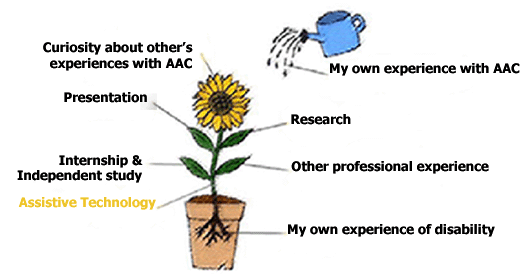Assistive Technology

![]() My Journey into Assistive Technology (AT) field at George Mason University
My Journey into Assistive Technology (AT) field at George Mason University
Before I entered in Assistive Technology field, I studied in Computer Science for both bachelor and master program. After graduating master program, I was seeking for computer job. While searching a job, I was pregnant of my first child. My husband and I decided to postpone to get a job until my child was born. While I was expecting, I thought over my future career. In fact, I always thought that my ultimate goal for my future was working for people with disabilities, whatever I studied. After deep thought, I concluded that having a background in the Special Education field is essential to better benefit the disability community. While searching a school which I could have opportunity a special education field, I was very lucky to find Assistive Technology (AT) at George Mason University. I think that choosing AT program was right for me because it combines my strong background in the computer field (technology) and my interest in working for people with disabilities.
![]() The courses related to AT that I've taken at GMU
The courses related to AT that I've taken at GMU
Spring, 1999
EDSE 517 Computer Applications for Special Populations (3:3:0). Prerequisites: Graduate standing or permission of instructor. Presents a lecture/laboratory course for teachers of special populations (e.g., children with disabilities, bilingual children) in applications of computer technology for instructional programs and computer skills. Students learn to use computer technology designed for special populations.
Fall, 1999
EDSE 622 Augmentative Communication (3:3:0). Prerequisites: Graduate standing, EDSE 552 (can be taken concurrently), and permission of advisor. Focuses on alternative language and communication techniques for children with severe language and speech impairments.
Summer, 2000
EDIT 523 / EDSE 523 Accessibility/Input Modification (1-3: 1-3: 0). Provides students with an overview of accessibility/input modifications and strategies. Students explore various input devices and their application and use by individuals with disabilities. Opportunities for in-depth exploration of sophisticated access technologies are made available to those students who seek expertise in specific assistive technology devices. Knowledge and awareness components of this course may be delivered via distance education.
EDIT 525 / EDSE 525 Software for Individuals with Special Needs (1-2:-1-2:0). Focuses on software evaluation and design for individuals with disabilities. Students have the opportunity to explore existing software resources and identify design features to meet an individual's special needs. Students create a software program for a person with disabilities (Credit 2). Knowledge and awareness components of this course may be delivered via distance education.
Spring, 2001
EDSE 649 Advanced Clinical Psycho-Educational Assessment in Special Education - Assistive Technology (3:3:0). Prerequisite: EDSE 648 is required for ED/LD students. Focuses on advanced issues in administering, scoring, and interpreting education evaluation instruments with an emphasis on writing reports and developing the Individualized Education Program. Considers using assessment results for instructional and placement decisions.
EDIT 522 / EDSE 522 Assistive Technology for Individuals with Sensory Impairments (2-3:2-3:0). Focuses on professionals and/or students interested in serving the visually impaired/blind or hearing impaired/deaf populations. Heightens the awareness of participants to specific technology and resources available to enhance and improve the ability of individuals with hearing and visual impairments to succeed in school, daily living activities, and employment. Knowledge and awareness components of this course may be delivered via distance education.
Fall, 2001
EDSE 528 Low-Tech Assistive Technology Solutions (1:1:0). Focuses on functional applications of low-technology solutions within the areas of self-care; mobility and transfer communication; stability and support; sports, recreation, and leisure; and academic and work environments. The course includes exploration and opportunities to design and create low-tech devices for children and adults. Knowledge and awareness components of this course may be delivered via distance education.
Spring, 2002
EDIT 526 / EDSE 526 Assistive Technology and the Internet (2:2:0). Provides an overview of the World Wide Web/Internet. The primary focus is on accessibility issues and solutions. Students perform web searches, and design and produce an informational web page. Knowledge and awareness components of this course may be delivered via distance education.
EDIT 797 / EDUC 797 Advanced Topics in Education (Special Topic: Augmentative Communication Tools) (3:3:0). This course reviews a sampling of augmentative and alternative communication tools on the market. Topics covered include demonstrations of the devices as well as customization, modification, and implementation of the tools in various environments and with various users.
Fall, 2002
EDSE 610 Designing Adaptive Environments (2:2:0). Provides an overview of environmental adaptations for people with disabilities to increase their access to community, workplace, and school activities. The course covers legal issues within the ADA for adapting environments, and addresses programmatic and physical access issues. Knowledge and awareness components of this course may be delivered via distance education.
![]()
My own experience of disability | Assistive Technology | Presentation | Research | Internship & Independent study
Other professional experience | My own experience with AAC | Curiosity about other's experiences with AAC
